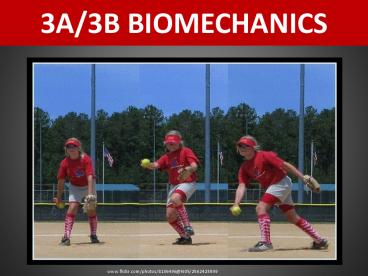3A/3B BIOMECHANICS - PowerPoint PPT Presentation
1 / 16
Title:
3A/3B BIOMECHANICS
Description:
3A/3B BIOMECHANICS www.flickr.com/photos/8136496_at_N05/2562423599 Movement principles and concepts Unit: 3A Scope & Sequence Elaboration The principle of Inertia ... – PowerPoint PPT presentation
Number of Views:160
Avg rating:3.0/5.0
Title: 3A/3B BIOMECHANICS
1
3A/3B BIOMECHANICS
www.flickr.com/photos/8136496_at_N05/2562423599
2
Physical Education Studies Elaboration Support
Document, 2008
3
Physical Education Studies Elaboration Support
Document, 2008
4
STRUCTURE OF SKELETAL MUSCLE
5
IMPULSE MOMENTUM RELATIONSHIP
Which method would you prefer to use when
catching a ball a large force over a short
period of time or a smaller peak force over a
longer period of time?
FORCE
FORCE
TIME
TIME
6
IMPULSE AND ACCURACY
- FLATTENING THE SWING ARC
- Good technique can? contact time with a ball
during collision sports - May provide opportunity for ? force application
in desired direction (hockey drag flick) - May also provide ? accuracy, however usually
occurs with a ? in force application
A more curved arc reduces the likelihood of a
successful outcome by reducing the opportunity
for application of force in the intended
direction of travel
Flattening the arc increases the likelihood of
application of force to object in desired
direction of travel by creating a zone of flat
line motion
7
IMPULSE AND SPORT
- Because impulse is force time, we can change
either one to suit the demands of the situation - INCREASING MOMENTUM
- In hockey a hit will place a large force, but
over a small time. A drag flick would use a
smaller force over a longer period of time.
Either way the ball will increase its momentum - Ideally we look to maximise both force and time,
however the human body rarely allows for this to
happen.
Large backswing ensures maximum force is applied,
but over a short period of time
Wides stance aims to maximise impulse by ?
contact time, however force generated will be low
compared to the hit
www.flickr.com/photos/mark_fletcher/2325626998/siz
es/s/
www.flickr.com/photos/stephanderson/2190910716
8
IMPULSE AND SPORT
- DECREASING MOMENTUM
- A cricket ball is hit towards a fielder. The
fielder wishes to stop the ball (take momentum
back to zero). - Would he apply a large force over a short period
of time - Would he apply a small force over a longer period
of time. - Which method is likely to be more successful in
catching the ball? - Therefore in stopping a force we usually increase
the time component so we can reduce the peak
force!
9
MECHANICAL CHARACTERISTICS OF MUSCLE
- FORCE VELOCITY
- Muscle can create ? force with a ? velocity of
concentric contraction - Muscle can resist ? force with a ? velocity of
eccentric contraction
CONCENTRIC
ECCENTRIC
Its easier to lift a heavy weight concentrically
(upwards) slowly than it is quickly!
Its easier to resist a heavy weight
eccentrically (lowering) quickly rather than
slowly
10
MECHANICAL CHARACTERISTICS OF MUSCLE
- FORCE VELOCITY
During isometric contraction, force generated
does not result in change of muscle length
During concentric muscle contraction
(shortening), max force achieved during minimum
velocity
FORCE
During eccentric muscle contraction (lengthening)
, max force achieved during max velocity
LENGTHENING VELOCITY
SHORTENING VELOCITY
0
11
LEVERS - ANATOMY
- Fulcrum point around which the lever rotates
- Effort Arm The part of the lever that the
effort force is applied to (measured from the
fulcrum to the point at which the force is
applied) - Resistance Arm The part of the lever that
applies the resistance force (measured from the
fulcrum to the center of the resistance force) - Input (Effort) Force Force exerted ON the lever
- Output (Resistance) Force Force exerted BY the
lever
RESISTANCE FORCE
EFFORT FORCE
RESISTANCE ARM
EFFORT ARM
FULCRUM
12
LEVERS - PRINCIPLES
- Velocity is greatest at the distal end of a lever
- Longer the lever, greater the velocity at impact
- E.g. Golf driver vs. 9 iron
- ? club length creates ? velocity and momentum at
impact provided the athlete can control the
longer lever longer generally means? mass! - Children often have difficulty with this and
subsequently use shorter levers to gain better
control shorter cricket bat, tennis racquet etc
www.flickr.com/photos/flash716/2578346899/
www.flickr.com/photos/cwalker71/2455913000/
13
ANGULAR MOMENTUM MOMENT OF INERTIA (rotational
inertia)
- If the bodys mass is close to the axis of
rotation, rotation is easier to manipulate. This
makes the moment of inertia smaller and results
in an increase in angular velocity. - Moving the mass away from the axis of rotation
slows down angular velocity.
Try this on a swivel chair see which method
will allow you to spin at a faster rate? Note
what happens when you move from a tucked position
(left) to a more open position (right).
14
CONSERVATION OF ANGULAR MOMENTUM
Angular momentum
Moment of inertia
Angular velocity high, moment of inertia low
Angular velocity low, moment of inertia high
Angular velocity
Angular momentum remains constant
TIME
15
TURBULENT FLOW
LAMINAR FLOW
Late boundary layer separation
Early boundary layer separation
High pressure at front of ball
High pressure at front of ball
Small turbulent pocket (high pressure) at rear of
ball
Large turbulent pocket (low pressure) at rear of
ball
Turbulent flow causes the boundary layer
separation to take place later. This causes a
smaller pressure differential between the front
and back of the ball as their is only a small
pocket of turbulent wake at the rear of the ball
Laminar flow causes the boundary layer separation
to take place earlier. This causes a larger
pressure differential between the front and rear
of the ball as their is now a large pocket of
turbulent wake at the back of the ball
16
(No Transcript)































